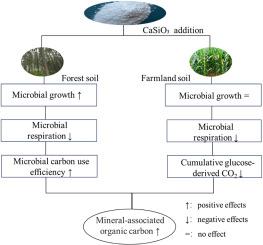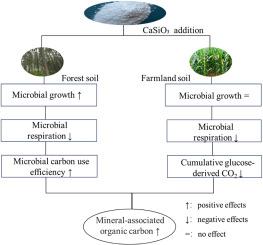相似的矿物相关有机碳形成,但在两种土壤之间添加粉状硅灰石的效率不同
IF 10.3
1区 农林科学
Q1 SOIL SCIENCE
引用次数: 0
摘要
最近的研究表明,在土壤中施用硅酸盐粉末(如硅灰石)可以增强土壤有机碳(SOC)的固存。然而,矿物相关有机碳(MAOC)的形成是否以及如何受到这种做法的影响在很大程度上是未知的。在这里,我们将13c标记的葡萄糖以5%的SOC的速率添加到森林和农田土壤中,并添加和不添加CaSiO3粉末(分析级)(烘箱干燥土壤质量的5%),进行了60天的培养实验。采用18O标记法测定微生物碳利用效率(CUE)和生物量周转。我们发现,添加CaSiO3后,森林土壤中的13c -矿物相关有机碳(13C-MAOC)显著增加了~ 171%,农田土壤中的13C-MAOC显著增加了~ 252%。添加CaSiO3后,农田土壤中13c颗粒有机碳(13C-POC)显著增加156%。因此,森林土壤中13C-MAOC相对于13C-POC的形成比例高于农田土壤。森林土壤13C-MAOC升高可能与pH升高(3.5单位)导致微生物CUE升高(128.5%)有关。尽管微生物CUE没有显著增加,但相对于森林土壤,CaSiO3的添加降低了农田土壤中葡萄糖衍生的CO2。这些结果表明,微生物可能在合成代谢途径中利用了更多的葡萄糖,导致农田土壤的MAOC形成效率高于森林土壤。总的来说,我们的研究结果强调CaSiO3添加可以促进MAOC的形成,但效率可能取决于土壤类型。本文章由计算机程序翻译,如有差异,请以英文原文为准。


Similar mineral-associated organic carbon formation but distinct efficiencies by powdered wollastonite addition between two soils
Recent studies showed that application of silicates powders (e.g., wollastonite) to soils can enhance soil organic carbon (SOC) sequestration. However, whether and how the formation of mineral-associated organic carbon (MAOC) is affected by this practice is largely unknown. Here, we added 13C-labeled glucose at a rate of 5 % SOC to a forest and a farmland soil with and without CaSiO3 powder (analytical grade) addition (5 % of oven-dried soil mass) in a 60-day incubation experiment. Microbial carbon use efficiency (CUE) and biomass turnover were measured using a18O labelling method. We found that 13C-mineral associated organic carbon (13C-MAOC) was significantly increased by ∼ 171 % in the forest soil, and by ∼ 252 % in the farmland soil by CaSiO3 addition. CaSiO3 addition also significantly increased 13C-particulate organic carbon (13C-POC) by 156 % in the farmland soil. As such, the forest soil had a higher percentage of 13C-MAOC formed relative to 13C-POC than the farmland soil. The increased 13C-MAOC in the forest soil is likely related to the increased microbial CUE (128.5 %) due to increased pH (3.5 units). Despite no significant increase in microbial CUE, CaSiO3 addition decreased glucose-derived CO2 in the farmland soil relative to the forest soil. These results suggest that more glucose may have been utilized in the anabolic pathway by microorganisms, leading to higher MAOC formation efficiency in the farmland soil than the forest soil. Overall, our results highlight that CaSiO3 addition can promote MAOC formation, but the efficiency may depend on soil type.
求助全文
通过发布文献求助,成功后即可免费获取论文全文。
去求助
来源期刊

Soil Biology & Biochemistry
农林科学-土壤科学
CiteScore
16.90
自引率
9.30%
发文量
312
审稿时长
49 days
期刊介绍:
Soil Biology & Biochemistry publishes original research articles of international significance focusing on biological processes in soil and their applications to soil and environmental quality. Major topics include the ecology and biochemical processes of soil organisms, their effects on the environment, and interactions with plants. The journal also welcomes state-of-the-art reviews and discussions on contemporary research in soil biology and biochemistry.
 求助内容:
求助内容: 应助结果提醒方式:
应助结果提醒方式:


